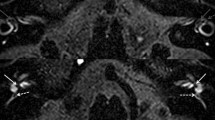Abstract
Introduction
Unilateral vestibular atelectasis (UVA), an entity first described by Merchant and Schuknecht in 1988, has rarely been reported in vivo as of yet. We specify here the clinical characteristics of 22 patients diagnosed with UVA.
Materials and methods
Patients with a radiological diagnosis of UVA who underwent delayed inner ear MRI were included between April 2017 and January 2020. Full clinical testing including ocular infrared video-oculography, oVEMPs, cVEMPs, vHIT, bithermal caloric testing and auditory testing was performed.
Results
There were 13 men and 9 women, of mean age 58.6 ± 13.7 years. Onset was more frequently sudden (73%) than insidious (27%) though both clinical presentations were reported, and positional vertigo was described in 41% of cases. There were only two (9%) patients reporting Tullio’s phenomenon. Vestibular testing showed that in 90% of cases, there was utricular dysfunction on oVEMP, while in 77% of cases, saccular function was preserved on cVEMP. vHIT showed high-velocity canal function impairment in all 22 patients: 8 patients (36%) had one impaired canal, 5 (23%) had two and 9 (41%) had all three canals affected. Caloric tests found complete unilateral areflexia, in 65% of tested cases, and partial deficiency in 35% of cases. Nine patients (40%) displayed asymmetrical hearing.
Conclusion
We described in this study the various clinical presentations of a disease rarely reported in vivo, UVA. Initial clinical presentation can appear similar to an acute vestibular deficit, a recurrent positional vertigo, or fluctuating dizziness.




Similar content being viewed by others
References
Merchant SN, Schuknecht HF (1988) Vestibular atelectasis. Ann Otol Rhinol Laryngol 97(6):565–576. https://doi.org/10.1177/000348948809700601
Wenzel A, Ward BK, Schubert MC et al (2014) Patients with vestibular loss, Tullio phenomenon, and pressure-induced nystagmus: vestibular atelectasis? Otol Neurotol 35(5):866–872. https://doi.org/10.1097/MAO.0000000000000366
Finn S, Dietzek M, Karvouniari P et al (2018) Bilateral vestibulopathy with positive tullio phenomenon: bilateral vestibulopathy and Tullio phenomenon. Laryngoscope 128(5):1223–1225. https://doi.org/10.1002/lary.26690
Roy S, Kumarasamy G, Salim R (2019) Bilateral vestibular atelectasis with Tullio’s phenomenon. Indian J Otolaryngol Head Neck Surg. https://doi.org/10.1007/s12070-019-01685-z
Maslovara S, Butkovic-Soldo S, Pajic-Matic I, Sestak A (2018) Vestibular atelectasis: Decoding pressure and sound-induced nystagmus with bilateral vestibulopathy. Laryngoscope. https://doi.org/10.1002/lary.27724
Eliezer M, Attyé A, Guichard J-P et al (2019) Vestibular atelectasis: myth or reality?: vestibular atelectasis. Laryngoscope 129(7):1689–1695. https://doi.org/10.1002/lary.27793
Eliezer M, Toupet M, Vitaux H et al (2019) MRI evidence of vestibular atelectasis in bilateral vestibulopathy and Tullio phenomenon. Otol Neurotol 40(9):e944–e946. https://doi.org/10.1097/MAO.0000000000002409
Eliezer M, Poillon G, Gillibert A et al (2018) Comparison of enhancement of the vestibular perilymph between gadoterate meglumine and gadobutrol at 3-Tesla in Meniere’s disease. Diagn Interv Imaging 99(5):271–277. https://doi.org/10.1016/j.diii.2018.01.002
Kahn L, Hautefort C, Guichard J et al (2019) Relationship between video head impulse test, ocular and cervical vestibular evoked myogenic potentials, and compartmental magnetic resonance imaging classification in menière’s disease. Laryngoscope. https://doi.org/10.1002/lary.28362
Eliezer M, Poillon G, Lévy D et al (2020) Clinical and radiological characteristics of patients with collapse or fistula of the saccule as evaluated by inner ear MRI. Acta Otolaryngol 10(1080/00016489):1713396
Eliezer M, Toupet M, Guichard JP, Houdart E, Kania R, Hautefort C. Perilymphatic fistula: consideration based on MRI and surgery. (Press)
Rubin F, Simon F, Verillaud B, Herman P, Kania R, Hautefort C (2018) Comparison of video head impulse test and caloric reflex test in advanced unilateral definite Menière’s disease. Eur Ann Otorhinolaryngol Head Neck Dis 135(3):167–169. https://doi.org/10.1016/j.anorl.2017.08.008
Egami N, Ushio M, Yamasoba T, Yamaguchi T, Murofushi T, Iwasaki S (2013) The diagnostic value of vestibular evoked myogenic potentials in patients with Meniere’s disease. J Vestib Res 23(4,5):249–257. https://doi.org/10.3233/VES-130484
Maxwell R, Jerin C, Gürkov R (2017) Utilisation of multi-frequency VEMPs improves diagnostic accuracy for Meniere’s disease. Eur Arch Otorhinolaryngol 274(1):85–93. https://doi.org/10.1007/s00405-016-4206-z
Tomanovic T, Bergenius J (2014) Vestibular findings in patients with persistent geotropic positional nystagmus: the 'light cupula' phenomenon. Acta Otolaryngol 134(9):904–914. https://doi.org/10.3109/00016489.2014.928421
Tarnutzer A, Bockisch CJ, Buffone E, Weiler S, Bachmann LM, Weber KP (2016) Disease-specific sparing of the anterior semicircular canals in bilateral vestibulopathy. Clin Neurophysiol 127(8):2791–2801. https://doi.org/10.1016/j.clinph.2016.05.005
Dlugaiczyk J (2020) Evidenzbasierte VEMP-Diagnostik: Von den neurophysiologischen Grundlagen zur klinischen Anwendung [Evidence-based diagnostic use of VEMPs: from neurophysiological principles to clinical application. German version]. HNO 68(5):324–335
Hofman R, Segenhout JM, Buytaert JAN, Dirckx JJJ, Wit HP (2008) Morphology and function of Bast’s valve: additional insight in its functioning using 3D-reconstruction. Eur Arch Otorhinolaryngol 265(2):153–157. https://doi.org/10.1007/s00405-007-0424-8
Hibino H, Kurachi Y (2006) Molecular and physiological bases of the K + circulation in the mammalian inner ear. Physiology 21(5):336–345. https://doi.org/10.1152/physiol.00023.2006
Teggi R, Carpini SD, Zagato L (2019) Endolymphatic hydrops and ionic transporters: genetic and biohumoral aspects. J Neurol 266:47–51. https://doi.org/10.1007/s00415-019-09399-6
Eliezer M, Maquet C, Horion J et al (2019) Detection of intralabyrinthine abnormalities using post-contrast delayed 3D-FLAIR MRI sequences in patients with acute vestibular syndrome. Eur Radiol 29(6):2760–2769. https://doi.org/10.1007/s00330-018-5825-0
Tagaya M, Yamazaki M, Teranishi M et al (2011) Endolymphatic hydrops and blood–labyrinth barrier in Ménière’s disease. Acta Otolaryngol 131(5):474–479. https://doi.org/10.3109/00016489.2010.534114
Funding
None.
Author information
Authors and Affiliations
Corresponding author
Ethics declarations
Conflicts of interest
None.
Ethical approval
All human and animal studies have been approved by the appropriate ethics committee and have therefore been performed in accordance with the ethical standards laid down in the 1964 Declaration of Helsinki and its later amendments.
Informed consent
All persons gave their informed consent prior to their inclusion in the study.
Electronic supplementary material
Below is the link to the electronic supplementary material.
Rights and permissions
About this article
Cite this article
Marc, M., Hautefort, C., Guichard, JP. et al. Clinical characteristics in unilateral vestibular atelectasis. J Neurol 268, 689–700 (2021). https://doi.org/10.1007/s00415-020-10220-y
Received:
Revised:
Accepted:
Published:
Issue Date:
DOI: https://doi.org/10.1007/s00415-020-10220-y




